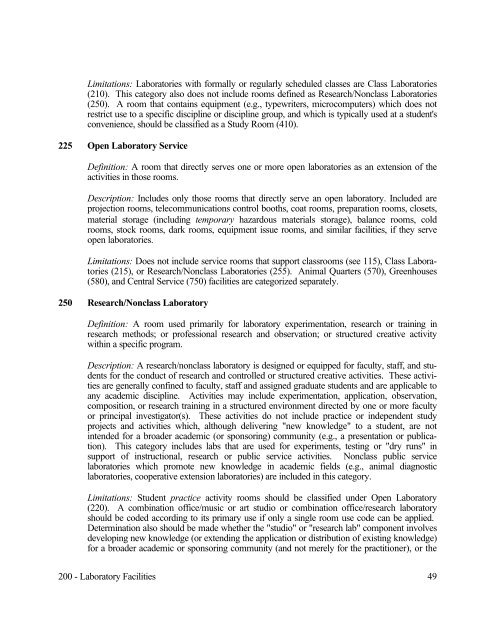Room Use Codes & Definitions
Room Use Codes & Definitions
Room Use Codes & Definitions
Create successful ePaper yourself
Turn your PDF publications into a flip-book with our unique Google optimized e-Paper software.
Limitations: Laboratories with formally or regularly scheduled classes are Class Laboratories(210). This category also does not include rooms defined as Research/Nonclass Laboratories(250). A room that contains equipment (e.g., typewriters, microcomputers) which does notrestrict use to a specific discipline or discipline group, and which is typically used at a student'sconvenience, should be classified as a Study <strong>Room</strong> (410).225 Open Laboratory ServiceDefinition: A room that directly serves one or more open laboratories as an extension of theactivities in those rooms.Description: Includes only those rooms that directly serve an open laboratory. Included areprojection rooms, telecommunications control booths, coat rooms, preparation rooms, closets,material storage (including temporary hazardous materials storage), balance rooms, coldrooms, stock rooms, dark rooms, equipment issue rooms, and similar facilities, if they serveopen laboratories.Limitations: Does not include service rooms that support classrooms (see 115), Class Laboratories(215), or Research/Nonclass Laboratories (255). Animal Quarters (570), Greenhouses(580), and Central Service (750) facilities are categorized separately.250 Research/Nonclass LaboratoryDefinition: A room used primarily for laboratory experimentation, research or training inresearch methods; or professional research and observation; or structured creative activitywithin a specific program.Description: A research/nonclass laboratory is designed or equipped for faculty, staff, and studentsfor the conduct of research and controlled or structured creative activities. These activitiesare generally confined to faculty, staff and assigned graduate students and are applicable toany academic discipline. Activities may include experimentation, application, observation,composition, or research training in a structured environment directed by one or more facultyor principal investigator(s). These activities do not include practice or independent studyprojects and activities which, although delivering "new knowledge" to a student, are notintended for a broader academic (or sponsoring) community (e.g., a presentation or publication).This category includes labs that are used for experiments, testing or "dry runs" insupport of instructional, research or public service activities. Nonclass public servicelaboratories which promote new knowledge in academic fields (e.g., animal diagnosticlaboratories, cooperative extension laboratories) are included in this category.Limitations: Student practice activity rooms should be classified under Open Laboratory(220). A combination office/music or art studio or combination office/research laboratoryshould be coded according to its primary use if only a single room use code can be applied.Determination also should be made whether the "studio" or "research lab" component involvesdeveloping new knowledge (or extending the application or distribution of existing knowledge)for a broader academic or sponsoring community (and not merely for the practitioner), or the200 - Laboratory Facilities 49
















